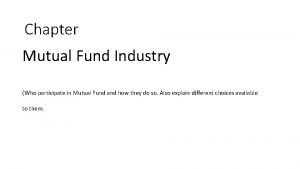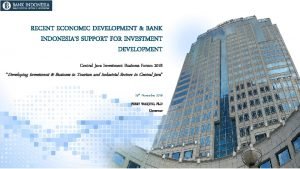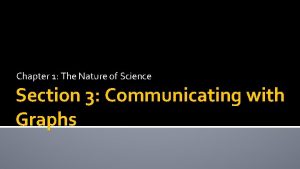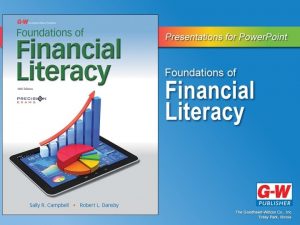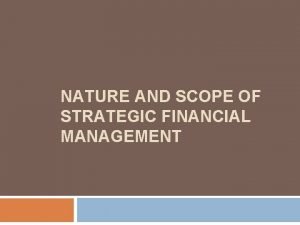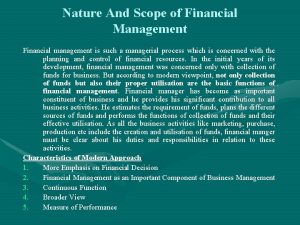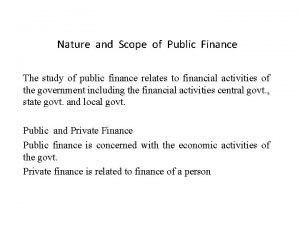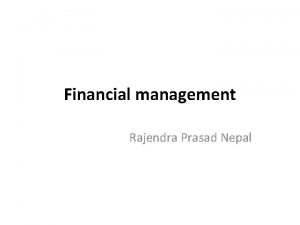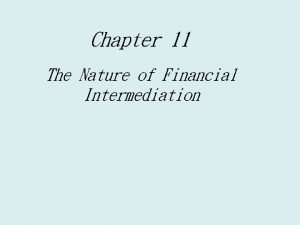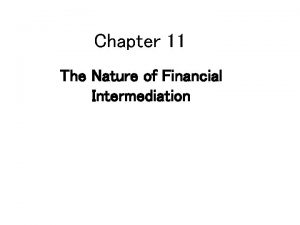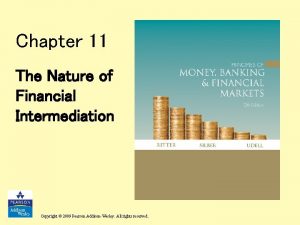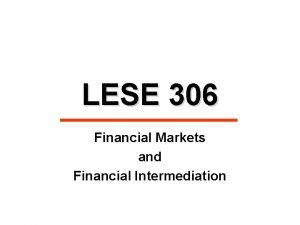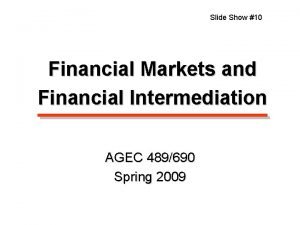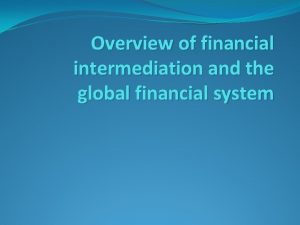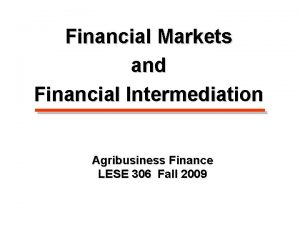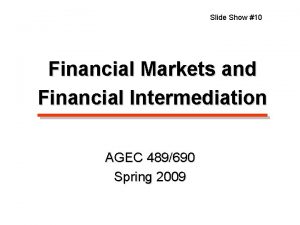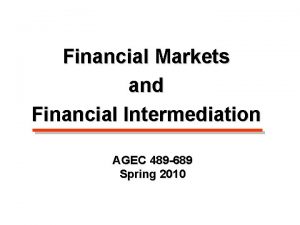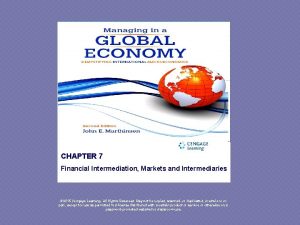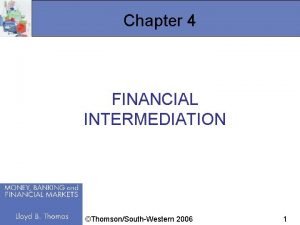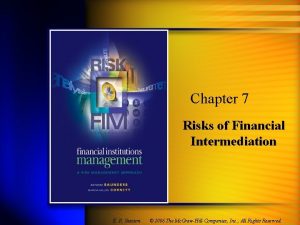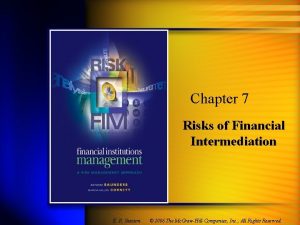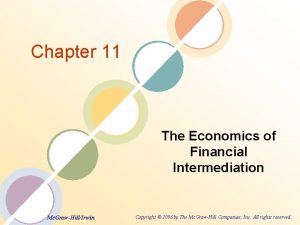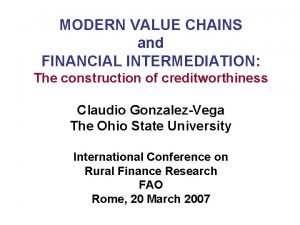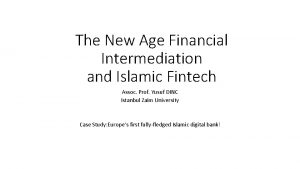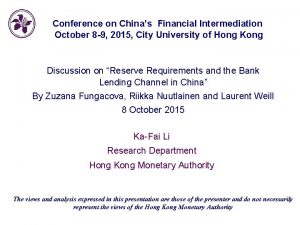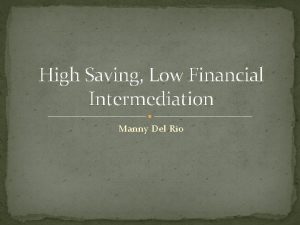Chapter 11 The Nature of Financial Intermediation KEY
































- Slides: 32

Chapter 11 The Nature of Financial Intermediation

KEY TERMS AND CONCEPTS Financial Intermediation – p. 195, 597 Portfolio Diversification – p. 196, 603 Depository and Non-depository Institutions – p 212, 214 Regulation Q (regulations) Concept of Bank Innovations Money Market Mutual Funds – p. 203 Institutionalization – p. 207 Copyright © 2004 Pearson Addison-Wesley. All rights reserved. 11 -2

DISCUSSION QUESTIONS 1. Why do we need financial intermediaries like banks? 2. What are the reasons your parents and you need or will use financial intermediaries? 3. What are some of the financial intermediaries we have talked about in this course? 4. What is the most important product for a bank and it’s largest type of asset? Copyright © 2004 Pearson Addison-Wesley. All rights reserved. 11 -3

Copyright © 2004 Pearson Addison-Wesley. All rights reserved. 3 -4

LESSON OBJECTIVES 1. The 3 main reasons for financial intermediation 2. The 2 main categories of Financial Intermediaries (Institutions). 3. Regulation and Innovation Copyright © 2004 Pearson Addison-Wesley. All rights reserved. 11 -5

Flow of funds through the Financial System Copyright © 2004 Pearson Addison-Wesley. All rights reserved. 11 -6

The Economics of Financial Intermediation 中介 Zhōngjiè p. 196 • Reasons for Financial Intermediation 1. Reduce Transaction 交易Jiāoyì costs by bringing lenders and borrowers together 2. Portfolio Diversification and risk sharing by providing many different products and services for customers. 3. Provide Information so savers, lenders, borrowers and investors can make good decisions. Copyright © 2004 Pearson Addison-Wesley. All rights reserved. 11 -7

LOANS AND INFORMATION P. 198 -199 LOANS are the most important product and largest type of assets for banks. Next semester when we learn more about loans and will learn the following terms: Asymmetric Information has 2 forms: Adverse Selection Moral Hazard Copyright © 2004 Pearson Addison-Wesley. All rights reserved. 11 -8

TWO MAIN TYPES OF FINANCIAL INTERMEDIARIES p. 212 -214 • Depository Institutions Banks Credit Unions Savings and Loans • Non-Depository Institutions Insurance Companies Pension (Retirement) Funds Finance Companies Mutual Fund Companies Copyright © 2004 Pearson Addison-Wesley. All rights reserved. 11 -9

The Evolution of Financial Intermediaries in the US p. 200 • The institutions, intermediaries are very dynamic 动态 (Dòngtài), complex and have changed over the years. • Two main reasons for the changes made in financial institutions (intermediaries): – Government Regulations – Laws that intermediaries must follow – Innovations – Both financial and technological Copyright © 2004 Pearson Addison-Wesley. All rights reserved. 11 -10

The Evolution of Financial Intermediaries in the US p. 200 • Due to the changes we can see the effects from the following tables. • Table 11. 1 and 11. 2 for relative importance of different types of institutions and how this has changed from 1952 to 2002 – Winners—Pension funds and mutual fund – Losers—Depository institutions (except credit unions) and life insurance companies Copyright © 2004 Pearson Addison-Wesley. All rights reserved. 11 -11

Table 11. 1 Financial Intermediary Assets in the United States, 1952– 2002 (in billions of dollars) p. 201 Copyright © 2004 Pearson Addison-Wesley. All rights reserved. 11 -12

Table 11. 2 Share of Financial Intermediary Assets in the United States, 1952 -2002 (in billions of dollars) p. 202 Copyright © 2004 Pearson Addison-Wesley. All rights reserved. 11 -13

GOVERNMENT REGULATION CASE STUDY • Where do Banks get money for loans? • HOUSEHOLDS (YOU AND ME) • What do people want to get from their deposits in the bank? • INTEREST • What do banks need when the demand for loans increases? • NEED MORE DEPOSITS • But the FED put a ceiling (limit) on the amount a bank could pay depositors in interest – REGULATION Q Copyright © 2004 Pearson Addison-Wesley. All rights reserved. 11 -14

GOVERNMENT REGULATION CASE STUDY (cont) • WHAT COULD BE A PROBLEM OF THIS KIND OF GOVERNMENT REGULATION? • WHAT DID THE BANKS DO ABOUT IT? • Let’s take a look at what happened in America in the last 60 years? Copyright © 2004 Pearson Addison-Wesley. All rights reserved. 11 -15

The Evolution of Financial p. 200, 201 Intermediaries in the U. S. (Cont. ) • Example of Government Regulation Interest Rate Changes – 1950 s and early 1960 s • Stable interest rates • FED (Central Bank) put limits on what banks could pay in deposit rates, called: REGULATION Q • Therefore, large supply of cheap money Copyright © 2004 Pearson Addison-Wesley. All rights reserved. 11 -16

The Evolution of Financial p. 201, 202 Intermediaries in the U. S. (Cont. ) • Interest Rate Changes (Cont. ) – Mid-1960’s • Growing economy meant increased demand for loans • Bank loans jumped from 45% in 1960 to 60% in 1980 • Challenge for banks was to find enough deposits to satisfy loan demand – Depository institutions (banks, credit unions, savings and loans) still fell under protection of Regulation Q. Copyright © 2004 Pearson Addison-Wesley. All rights reserved. 11 -17

The Evolution of Financial p. 202 Intermediaries in the U. S. (Cont. ) • Why did the government think Regulation Q was necessary? 1. Promote stability in banking industry 2. Prevent “destructive” competition among banks to get funds by offering higher deposit rates 3. Higher cost of funds would increase costs and increase bank failures Copyright © 2004 Pearson Addison-Wesley. All rights reserved. 11 -18

The Evolution of Financial p. 202 Intermediaries in the U. S. (Cont. ) • Problems of Regulation Q – Rising short-term interest rates meant banks could not match rates earned in money market instruments such as T-bills and commercial paper. – So wealthy (rich) investors and corporations took money from depository institutions and placed in money market instruments. Copyright © 2004 Pearson Addison-Wesley. All rights reserved. 11 -19

The Evolution of Financial p. 203 Intermediaries in the U. S. (Cont. ) • WAS THE BANKS ANSWER TO THE PROBLEM OF REGULATION Q? • INNOVATION • Birth of the Money Market Mutual Fund – In 1971 Money Market mutual Funds were developed • Small investors “pooled their funds” to buy a diversified portfolio (different types) of money market instruments • Small investors now had access to money market interest rates in excess permitted by Regulation Q Copyright © 2004 Pearson Addison-Wesley. All rights reserved. 11 -20

Discussion Questions 1. What type of financial intermediaries have seen the most growth in the past 20 years? Which have seen the least growth? 2. What has been the biggest challenge for banks the last 20 -30 years? 3. What are regulations good for? Do you think they are necessary? What is Reg Q? How does it help banking? What is an example of how banks get around regulation? Copyright © 2004 Pearson Addison-Wesley. All rights reserved. 11 -21

The Evolution of Financial p. 207 Intermediaries in the U. S. (Cont. ) The Institutionalization of Financial Markets – Institutionalization (a structure or system) more and more funds now flow indirectly into financial markets through financial intermediaries rather than directly from savers – These “institutional (large company) investors” have become more important in financial markets relative to individual investors Copyright © 2004 Pearson Addison-Wesley. All rights reserved. 11 -22

Copyright © 2004 Pearson Addison-Wesley. All rights reserved. 11 -23

The Evolution of Financial p. 207 Intermediaries in the U. S. (Cont. ) • The Institutionalization (structure or system) of Financial Markets (Cont. ) – Reason for growth of institutionalization • Growth of pension funds and mutual funds • Tax laws encourage additional pensions and benefits rather than increased pay Copyright © 2004 Pearson Addison-Wesley. All rights reserved. 11 -24

The Evolution of Financial p. 208 Intermediaries in the U. S. (Cont. ) • The Institutionalization of Financial Markets (Cont. ) • Legislation created a number of new alternatives to the traditional employersponsored defined benefits plan, primarily the defined contribution plan – IRAs – 403(b) and 401(k) plans – Growth of mutual funds resulting from the alternative pension plans—Mutual fund families Copyright © 2004 Pearson Addison-Wesley. All rights reserved. 11 -25

The Evolution of Financial p. 208, 209 Intermediaries in the U. S. (Cont. ) • The Transformation (changes) of Traditional Banking – During 1970 s & 80 s banks extended loans to riskier borrowers – Increased competition from other financial institutions – Figure 11. 4, shows failures of banks during late 1980 s & early 1990 s Copyright © 2004 Pearson Addison-Wesley. All rights reserved. 11 -26

Figure 11. 4 Bank failures p. 209 Source: Federal Deposity Insurance Corporation, 2002 Annual Report Copyright © 2004 Pearson Addison-Wesley. All rights reserved. 11 -27

Financial Intermediaries: Assets, Liabilities, and Management (Cont. ) p. 210 – Interest Rate risks • Vulnerable to change in interest rates – Want a positive spread between interest earned on assets and cost of money (liabilities) – Attempt to maintain an equal balance between maturities of assets and liabilities – Adjustable rate on loans, mortgages, etc. minimizes interest rate risks Copyright © 2004 Pearson Addison-Wesley. All rights reserved. 11 -28

CHAPTER 11 SUMMARY 1. 3 main reasons for financial intermediaries: a. Reduce transaction costs; b. Diversification 投资组合多样化; c. Information Copyright © 2004 Pearson Addison-Wesley. All rights reserved. 11 -29

CHAPTER 11 SUMMARY (cont) 2. Deposits have gone down for banks. Banks are now competing for savers funds with pension funds, stock and bond mutual funds and finance companies 3. Interest rate limits and bank regulation (REG Q) has been a challenge for banks. Have to find other products to use for loan demands. Copyright © 2004 Pearson Addison-Wesley. All rights reserved. 11 -30

CHAPTER 11 SUMMARY (cont) 4. The Institutionalization or new system and structure has funds flowing through intermediaries indirectly, such as life insurance, pension funds, mutual funds. 5. Other types of finance companies are increasingly taking away the importance of banks as the biggest and most influential “players” Copyright © 2004 Pearson Addison-Wesley. All rights reserved. 11 -31

GROUP DISCUSSION QUESTIONS (1 member take down team notes) 1. What are the 3 main reasons for financial intermediation? 2. What are the 2 main categories or types of financial intermediaries (institutions)? What are some examples of each type? 3. What is an example of a regulation (law)? What is it called? And what did it do? 4. What is an example of how banks innovated (created a new product) to get around the regulation? 5. Can you describe this new innovation? 9 -32
 Financial intermediaries ppt
Financial intermediaries ppt Savers and investors role in financial markets
Savers and investors role in financial markets Financial intermediaries and markets
Financial intermediaries and markets Intermédiation financière caf
Intermédiation financière caf Denomination intermediation
Denomination intermediation Macroprudential intermediation ratio
Macroprudential intermediation ratio The nature of science communicating with graphs
The nature of science communicating with graphs The business model canvas
The business model canvas Contoh bisnis model canvas makanan pdf
Contoh bisnis model canvas makanan pdf Chapter 1 financial literacy basics
Chapter 1 financial literacy basics Nature and nature's laws lay hid in night meaning
Nature and nature's laws lay hid in night meaning Determinace lidské psychiky
Determinace lidské psychiky Scope of strategic financial planning
Scope of strategic financial planning The nature of financial management
The nature of financial management Nature of financial statement
Nature of financial statement Importance of public finance
Importance of public finance Nature of financial management
Nature of financial management Hát kết hợp bộ gõ cơ thể
Hát kết hợp bộ gõ cơ thể Lp html
Lp html Bổ thể
Bổ thể Tỉ lệ cơ thể trẻ em
Tỉ lệ cơ thể trẻ em Gấu đi như thế nào
Gấu đi như thế nào Tư thế worms-breton
Tư thế worms-breton Chúa yêu trần thế alleluia
Chúa yêu trần thế alleluia Môn thể thao bắt đầu bằng chữ f
Môn thể thao bắt đầu bằng chữ f Thế nào là hệ số cao nhất
Thế nào là hệ số cao nhất Các châu lục và đại dương trên thế giới
Các châu lục và đại dương trên thế giới Công của trọng lực
Công của trọng lực Trời xanh đây là của chúng ta thể thơ
Trời xanh đây là của chúng ta thể thơ Mật thư anh em như thể tay chân
Mật thư anh em như thể tay chân 101012 bằng
101012 bằng Phản ứng thế ankan
Phản ứng thế ankan Các châu lục và đại dương trên thế giới
Các châu lục và đại dương trên thế giới




